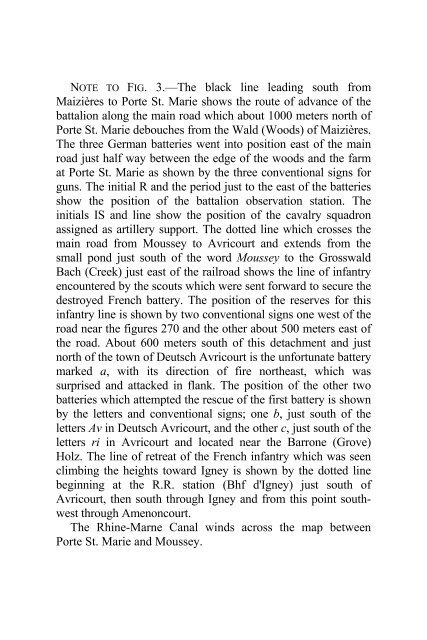the field artillery journal - Fort Sill - U.S. Army
the field artillery journal - Fort Sill - U.S. Army
the field artillery journal - Fort Sill - U.S. Army
You also want an ePaper? Increase the reach of your titles
YUMPU automatically turns print PDFs into web optimized ePapers that Google loves.
NOTE TO FIG. 3.—The black line leading south from<br />
Maizières to Porte St. Marie shows <strong>the</strong> route of advance of <strong>the</strong><br />
battalion along <strong>the</strong> main road which about 1000 meters north of<br />
Porte St. Marie debouches from <strong>the</strong> Wald (Woods) of Maizières.<br />
The three German batteries went into position east of <strong>the</strong> main<br />
road just half way between <strong>the</strong> edge of <strong>the</strong> woods and <strong>the</strong> farm<br />
at Porte St. Marie as shown by <strong>the</strong> three conventional signs for<br />
guns. The initial R and <strong>the</strong> period just to <strong>the</strong> east of <strong>the</strong> batteries<br />
show <strong>the</strong> position of <strong>the</strong> battalion observation station. The<br />
initials IS and line show <strong>the</strong> position of <strong>the</strong> cavalry squadron<br />
assigned as <strong>artillery</strong> support. The dotted line which crosses <strong>the</strong><br />
main road from Moussey to Avricourt and extends from <strong>the</strong><br />
small pond just south of <strong>the</strong> word Moussey to <strong>the</strong> Grosswald<br />
Bach (Creek) just east of <strong>the</strong> railroad shows <strong>the</strong> line of infantry<br />
encountered by <strong>the</strong> scouts which were sent forward to secure <strong>the</strong><br />
destroyed French battery. The position of <strong>the</strong> reserves for this<br />
infantry line is shown by two conventional signs one west of <strong>the</strong><br />
road near <strong>the</strong> figures 270 and <strong>the</strong> o<strong>the</strong>r about 500 meters east of<br />
<strong>the</strong> road. About 600 meters south of this detachment and just<br />
north of <strong>the</strong> town of Deutsch Avricourt is <strong>the</strong> unfortunate battery<br />
marked a, with its direction of fire nor<strong>the</strong>ast, which was<br />
surprised and attacked in flank. The position of <strong>the</strong> o<strong>the</strong>r two<br />
batteries which attempted <strong>the</strong> rescue of <strong>the</strong> first battery is shown<br />
by <strong>the</strong> letters and conventional signs; one b, just south of <strong>the</strong><br />
letters Av in Deutsch Avricourt, and <strong>the</strong> o<strong>the</strong>r c, just south of <strong>the</strong><br />
letters ri in Avricourt and located near <strong>the</strong> Barrone (Grove)<br />
Holz. The line of retreat of <strong>the</strong> French infantry which was seen<br />
climbing <strong>the</strong> heights toward Igney is shown by <strong>the</strong> dotted line<br />
beginning at <strong>the</strong> R.R. station (Bhf d'Igney) just south of<br />
Avricourt, <strong>the</strong>n south through Igney and from this point southwest<br />
through Amenoncourt.<br />
The Rhine-Marne Canal winds across <strong>the</strong> map between<br />
Porte St. Marie and Moussey.

















